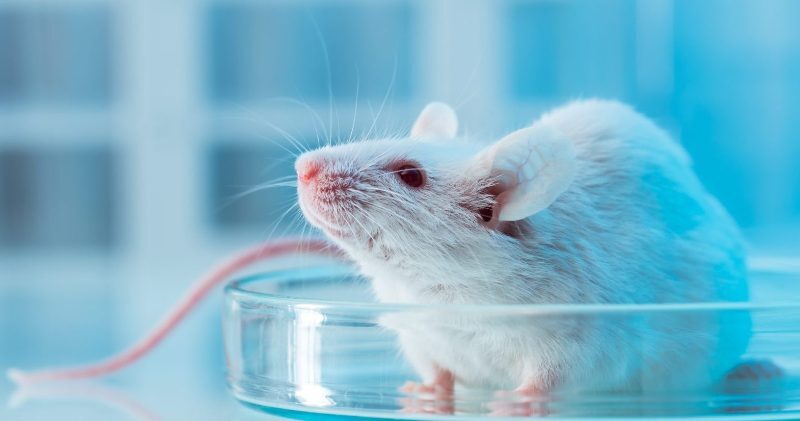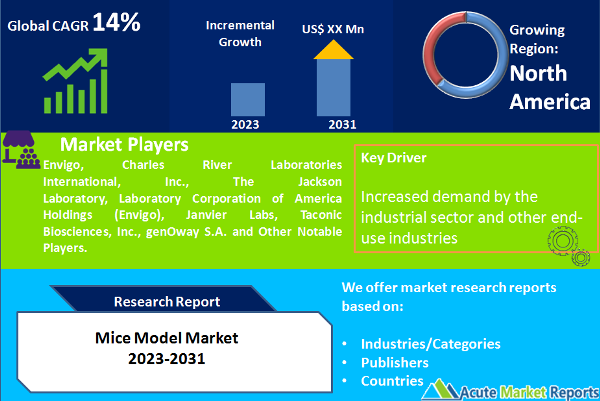
The global mice model market is expected to experience significant growth in the coming years, driven by several factors such as increasing demand for personalized medicine, advancements in genetic research, and rising prevalence of chronic diseases. The global mice model market size is expected to grow at a CAGR of 14% during the forecast period of 2024 to 2032. Mice models are widely used in medical research to study various diseases and disorders such as cancer, diabetes, and cardiovascular diseases. The increasing prevalence of these diseases worldwide is expected to drive the demand for mice models in the coming years. Additionally, the growing demand for personalized medicine and the need for preclinical testing of new drugs and therapies are expected to further drive market growth.Furthermore, the development of new genetically modified mice models and the advancements in genetic research are expected to significantly contribute to market growth. The use of mice models in studying the effects of specific genes and their interaction with the environment has provided a better understanding of various diseases and has facilitated the development of new treatments.Overall, the increasing demand for personalized medicine, advancements in genetic research, and rising prevalence of chronic diseases are expected to drive the growth of the mice model market in the coming years.

Advancements in Genetically Modified Mice Technology
The advent of genetically modified mice technology has been a game-changer for the Mice Model Market. The technology enables scientists to alter the genetic makeup of mice and create models that mimic human genetic disorders. This advancement has led to a surge in the demand for mice models, as they play a critical role in preclinical research for developing new therapies and drugs for various diseases. Moreover, this technology has also reduced the use of non-human primates in research, which has ethical and financial implications.
Rising Prevalence of Cancer and Other Chronic Diseases
The increasing prevalence of chronic diseases such as cancer, diabetes, and autoimmune diseases is another significant driver of the Mice Model Market. Mice models are extensively used to conduct research on the mechanisms of these diseases and test new therapies and drugs. According to the American Cancer Society, there were approximately 1.8 million new cancer cases and 0.6 million cancer deaths in the US in 2020. This highlights the significant demand for mice models to support cancer research and drug development.
Growing Demand for Personalized Medicine
There has been a growing trend in personalized medicine, which aims to tailor medical treatment to individual patients based on their genetic makeup. Mice models play a critical role in this field as they enable researchers to study the efficacy and safety of personalized drugs in preclinical trials. Moreover, mice models also facilitate the development of precision medicine by helping researchers to identify biomarkers and potential drug targets. As the demand for personalized medicine continues to increase, the demand for mice models is also expected to rise.
Stringent Regulations to Limit the Market Expansion
Restrictions on the use of animals in research are a significant restraint in the mice model market. Animal welfare concerns have led to strict regulations that must be followed to ensure ethical treatment and minimize suffering. These regulations have resulted in higher costs, increased time for regulatory approval, and limited availability of animals for research purposes. In some cases, the use of animals in research is completely prohibited, resulting in the need for alternative research methods, such as computer modeling or cell cultures. For instance, the European Union (EU) introduced Directive 2010/63/EU on the protection of animals used for scientific purposes, which mandates that animal experiments must be replaced with non-animal alternatives whenever possible. Similarly, in the United States, the Animal Welfare Act (AWA) and the Public Health Service Policy on Humane Care and Use of Laboratory Animals regulate the use of animals in research. These regulations have led to an increase in the use of alternative methods and technologies, such as in silico modeling, organ-on-a-chip, and in vitro assays, which may hinder the growth of the mice model market. However, despite these challenges, mice models remain a valuable tool in research, and continued innovation in animal welfare practices and alternative methods may help overcome some of these restraints.
Microinjection Segments Dominates the Market by Technology
The Mice Model Market can be segmented based on technology into CRISPR/CAS9, microinjection, embryonic stem cell injection, nuclear transfer, and other technologies. Among these segments, the CRISPR/CAS9 technology segment is expected to grow at the highest CAGR during the forecast period of 2024 to 2032. This is due to the advantages of the CRISPR/CAS9 technology, such as high precision and efficiency in generating genetically modified mice models. Additionally, this technology enables researchers to target specific genes and modify them with high accuracy, which is crucial for understanding the genetic basis of diseases and developing new treatments.In terms of revenue, the microinjection segment held the largest share in 2023. This is due to the wide application of this technology in generating transgenic mice models for studying a range of human diseases, including cancer, diabetes, and cardiovascular diseases. Microinjection enables researchers to introduce foreign DNA into the mouse genome, resulting in the development of genetically modified mice models that mimic human diseases.
Drug Discovery and Development Dominating the Market by Application
The global mice model market can be segmented based on its applications, which include drug discovery and development, basic research, and patient-derived xenograft (PDX) models/xenografts. Among these, the drug discovery and development segment held the largest market share in terms of revenue in 2023 and is expected to grow at a significant CAGR during the forecast period of 2024 to 2032. The growing demand for personalized medicine and increasing R&D activities by pharmaceutical companies are some of the key factors driving the growth of this segment. Moreover, mice models are widely used for preclinical studies to evaluate the safety and efficacy of new drugs. The basic research segment is also expected to grow at a substantial CAGR owing to the increasing investments by governments and private organizations in biomedical research. Additionally, the rising demand for genetically modified mice models for studying human diseases and their genetic basis is further contributing to the growth of this segment. The PDX models/xenografts segment is expected to witness moderate growth during the forecast period. These models are widely used for cancer research and drug development, as they mimic the biological behavior of human tumors.
North America remains as the Global Leader
North America dominated the market, accounting for the highest revenue percentage in 2023. This is due to the presence of advanced healthcare infrastructure, increased investment in research and development, and favourable government initiatives. The US is the leading market in the region, owing to the presence of several pharmaceutical and biotech companies, along with academic research institutes conducting extensive research on mice models. Europe follows North America in terms of revenue share, and the region is projected to witness significant growth during the forecast period due to increasing focus on personalized medicine and rising demand for humanized mice models. The Asia Pacific region is expected to witness the highest CAGR during the forecast period of 2024 to 2032, due to increasing investment in research and development activities, growing focus on drug discovery and development, and increasing outsourcing of research activities to countries like China and India. Latin America and the Middle East and Africa regions are also projected to witness significant growth during the forecast period due to the growing prevalence of chronic diseases and increasing government initiatives to support research and development activities.
Market Competition to Intensify During the Forecast Period
The global mice model market is highly competitive with the presence of various players. Some of the key players operating in the market include Envigo, Charles River Laboratories International, Inc., The Jackson Laboratory, Laboratory Corporation of America Holdings (Envigo), Janvier Labs, Taconic Biosciences, Inc., and genOway S.A. These companies are investing in R&D activities and new product development to maintain their position in the market.In addition, players are also focusing on strategic partnerships and collaborations to expand their market share. For instance, in 2020, Charles River Laboratories International, Inc. partnered with The National Institute of Allergy and Infectious Diseases (NIAID) to conduct preclinical research on COVID-19.Overall, the market players are focusing on various strategies to maintain their market position and expand their presence in the global mice model market. The increasing demand for mice models in various applications and the need for personalized medicine are expected to drive the growth of the market in the coming years.
Historical & Forecast Period
This study report represents analysis of each segment from 2022 to 2032 considering 2023 as the base year. Compounded Annual Growth Rate (CAGR) for each of the respective segments estimated for the forecast period of 2024 to 2032.
The current report comprises of quantitative market estimations for each micro market for every geographical region and qualitative market analysis such as micro and macro environment analysis, market trends, competitive intelligence, segment analysis, porters five force model, top winning strategies, top investment markets, emerging trends and technological analysis, case studies, strategic conclusions and recommendations and other key market insights.
Research Methodology
The complete research study was conducted in three phases, namely: secondary research, primary research, and expert panel review. key data point that enables the estimation of Mice Model market are as follows:
Market forecast was performed through proprietary software that analyzes various qualitative and quantitative factors. Growth rate and CAGR were estimated through intensive secondary and primary research. Data triangulation across various data points provides accuracy across various analyzed market segments in the report. Application of both top down and bottom-up approach for validation of market estimation assures logical, methodical and mathematical consistency of the quantitative data.
| ATTRIBUTE | DETAILS |
|---|---|
| Research Period | 2022-2032 |
| Base Year | 2023 |
| Forecast Period | 2024-2032 |
| Historical Year | 2022 |
| Unit | USD Million |
| Segmentation | |
Model Types & Services
| |
|
Region Segment (2022-2032; US$ Million)
|
Key questions answered in this report